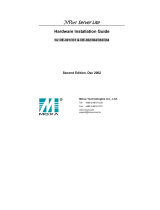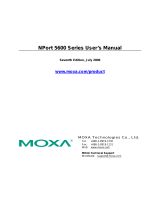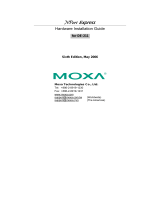Page is loading ...

NPort
Server Lite User’s Manual
for DE-302/304/332/334
Third Edition, March 2001
Moxa Technologies Co., Ltd.
Tel: +866-2-8919-1230
Fax: +886-2-8919-1231
www.moxa.com

NPort Server Lite User’s Manual
The software described in this manual is furnished under a license agreement and may be used only in
accordance with the terms of that agreement.
Copyright Notice
Copyright 2000 Moxa Technologies Co., Ltd.
All rights reserved.
Reproduction without permission is prohibited.
Trademarks
MOXA is a registered trademark of Moxa Technologies Co., Ltd.
All other trademarks or registered marks in this manual belong to their respective manufacturers.
Disclaimer
Information in this document is subject to change without notice and does not represent a commitment on
the part of Moxa.
Moxa provides this document “as is”, without warranty of any kind, either expressed or implied,
including, but not limited to, the particular purpose. Moxa reserves the right to make improvements
and/or changes to this manual or the product(s) and/or program(s) described herein at any time.
Information provided in this manual is intended to be accurate and reliable. However, Moxa Technologies
assumes no responsibility for its use, or for any infringements on the rights of fourth parties which may
result from its use.
This product could include technical or typographical errors. Changes are periodically made to the
information herein; these changes may be incorporated in new editions of the publication.

MOXA Internet Services
Customer satisfaction is one of our number one concerns. To ensure that customers receive the full
benefit of our products, Moxa Internet Services has been set up to provide technical support, driver
updates, product information, and user’s manual updates.
The following services are provided:
E-mail for technical support
address: [email protected]
FTP site for free driver updates
address: ftp://ftp.moxa.com
or
ftp://ftp.moxa.com.tw
user ID: ftp
password: your_email_address
World Wide Web (WWW) Site for product information
address: http://www.moxa.com
or
http://www.moxa.com.tw

Table of Contents
1.1 Overview..............................................................................................................1-1
Features....................................................................................................................1-2
Package Checklist .....................................................................................................1-2
Top/Front/Rear View.................................................................................................1-3
2.2 Getting Started ..................................................................................................2-1
Knowing Your Application ........................................................................................2-2
Host-Based Mode.................................................................................................................................2-2
Connecting the Hardware...........................................................................................2-3
Choosing a Location............................................................................................................................2-3
Network Connection............................................................................................................................2-5
Power Connection................................................................................................................................2-5
Serial Connection.................................................................................................................................2-5
3.3 Configuring the Network.................................................................................3-1
Preparing Windows NT/95/98 for a TCP/IP Network...................................................3-2
IP Address Configuration...........................................................................................3-2
LCD Panel.............................................................................................................................................3-2
Telnet Console......................................................................................................................................3-4
DHCP Configuration...........................................................................................................................3-6
4.4 Installation and Configuration.......................................................................4-1
Host-Based Mode......................................................................................................4-3
Single Host Mode ...............................................................................................................................4-3
Custom Mode......................................................................................................................................4-14
Upgrading NPort Server Lite Firmware.........................................................................................4-36
NPort Server Diagnostic ..........................................................................................4-37
Configuration......................................................................................................................................4-38
Viewer Status and Diagnose.............................................................................................................4-41
NPort Server Monitor ..............................................................................................4-44
Configuring NPort Server Monitor.................................................................................................4-44
Save and Load Configuration...........................................................................................................4-47

Upgrading NPort Server Firmware...........................................................................4-52
Uninstalling the Software.................................................................................................................4-57
5.5 Windows 2000 - Installation and Configuration.....................................5-1
Windows 2000 Driver Installation ..............................................................................5-2
Installing NPort Server Lite...............................................................................................................5-2
Installing NPort Server Lite’s Serial Port.........................................................................................5-9
NPort Server Lite Properties.....................................................................................5-11
Configuration......................................................................................................................................5-13
6.6 Troubleshooting................................................................................................6-1
Installation and Configuration Troubleshooting ...........................................................6-2
Programming Problems .............................................................................................6-5
A.A. Telnet Console..................................................................................................A-1
B.B.LCD Panel Configuration...............................................................................B-1
C.C.Cable Pinouts....................................................................................................C-1
D.D.Declaration of Conformity .............................................................................D-1


NPort Server Lite User’s Manual 1-1
1
1
1 Overview
Welcome to Moxa NPort Server Lite, an Industrial Serial Device Server that greatly
enhances the ability of a Windows NT/95/98 host to control multiple serial port devices
over a TCP/IP based Ethernet network.
This chapter is an introduction to NPort Server Lite and includes the following:
q Features
q Package Checklist
q Top/Front/Rear View
NPort Server Lite provides a data communication solution for connecting Windows
NT/95/98 hosts to multiple asynchronous RS-232 (models DE-302/304) or RS-422/485
(models DE-332/334) serial ports through a TCP/IP network. Each model has two
(DE-302/332) or four (DE-304/334) asynchronous serial port connections on one side, and
one 10/100M Ethernet connection on the other, allowing any device that supports primarily
the asynchronous communications protocol to attach to a network. NPort Server works like
an add-on multiport serial board to the NT/95/98 server, but with one major advantage – the
TCP/IP network. Since the Windows NT95/98 host communicates with the COM ports on
Nport Server Lite over a TCP/IP network, you are able to control asynchronous serial
devices from virtually anywhere in the world.
Although it connects through the virtual link of the Ethernet, the ports on NPort Server Lite
are recognized as real COM ports by the Windows NT/95/98 operating system. NPort
Server Lite provides both the basic transmit/receive data functions, as well as RTS, CTS,
DTR, DSR, and DCD control signals.
NPort Server Lite can be used with your existing applications that support serial
communication. It also comes with a utility program providing a simple step-by-step
installation procedure, and a maintenance wizard that gives you easy access to your
asynchronous devices.

1-2 NPort Server Lite User’s Manual
Features
q Built-In LCD Human Interface
q Long range connection through the Internet/Intranet between host and serial port
q Easy serial port expansion; up to 256 ports for one Windows NT host
q Supports sharing of the server or ports to multiple hosts
q Remote control of NPort Server through the Internet/Intranet
q Driver for Windows NT/95/98 platform
q Easy configuration and management under Windows NT/95/98
q Free Moxa PComm Pro Serial Control Library for easy serial device control
q Serial connection speed of 230.4 Kbps
Package Checklist
q One NPort Server Lite
q NPort Server Lite User's Manual
q MOXA PComm Pro, a professional serial Comm developing tool (on CD)
q PComm Pro registration card
q Cross-wired 10/100 Mbps Ethernet cable
q Power Adapter (110V or 230V)
q Windows NT/95/98 device driver (on diskette)
q Two attachment plates with 6 screws
Optional Accessory
q DIN Rail mounting kit (35 mm) with 4 screws

Overview
NPort Server Lite User’s Manual 1-3
Top/Front/Rear View
There are three network status LEDs located on the top panel of NPort Server Lite, each
with its own specific function.
LED name LED function
Power Turns green when power is supplied to the server.
Link Turns green when the Ethernet link is detected.
Traffic Blinks green while transferring data over the Ethernet.
Figure 1-1. NPort Server Lite—Top Panel (DE-302/304/332/334)
Figure 1-2. NPort Server Lite—Front Panel (DE-302/304/332/334)
Figure 1-3. NPort Server Lite—Back Panel (DE-302/304/332/334)
Network status LEDs
LCD display panel
Buttons for panel
configuration
DC IN 9Vdc to 30Vdc
10/100 Mbps Ethernet (RJ-45)
Reset: Press for 3
seconds to reset
password.
DB9 Male connectors
RS-232 for DE-302/304
RS-422/485 for DE-332/334
. Note: ModelsDE-302/332 have only two RS-232 or RS-422/485 ports.


NPort Server Lite User’s Manual 2-1
2
2
2 Getting Started
Now that you have been introduced to NPort Server Lite's features and specifications, it’s
time to install the hardware and get your system up and running.
We begin this chapter with a brief explanation of the operation mode available when using
NPort Server Lite. The surest and quickest way to get your system configured properly is to
first read everything in this chapter, and then start the actual installation process.
This chapter includes:
q Knowing Your Application
• Host Based Mode
q Connecting the Hardware
• Choosing a Location
Ø Desktop
Ø Wall or Cabinet
Ø DIN Rail
• Network Connection
• Power Connection
• Serial Connection

2-2 NPort Server Lite User’s Manual
Knowing Your Application
NPort Server Lite is an advanced Industrial Serial Device Server designed to fit into today's
ever-expanding networking world. It extends the usage of traditional COM ports on a
PC—an isolated machine with restricted ports—to being able to access the ports over a
TCP/IP network. Through the nature of networking, you can control your serial devices
from a distance, either over a LAN, or even over the Internet.
Since NPort Server Lite is connected through a TCP/IP network, you will need to know
some basic facts about networking in order to get the server hooked up correctly. In this
section we discuss the Host-Based Mode application.
Host-Based Mode
Traditional serial port communication uses a COM port board that slides into one of the
slots on the back of your PC. In this case, only the computer containing the board can
access the serial port. With Moxa’s 2/4-port NPort Server Lite serial device server,
communicating with COM ports is much more versatile, since you are now able to access
the COM ports from a distance. For example, the server could be located in Stockholm, and
the serial devices in Frankfurt.
Figure 2-1. NPort Server Lite—Host Based Mode

Getting Started
NPort Server Lite User’s Manual 2-3
Connecting the Hardware
In the previous section we illustrated the general operation mode of NPort Server Lite. We
begin this section by describing how to find a proper location for your server, and then
explain how to connect to the network, hook up the power cable, and connect to the
server’s serial port.
Choosing a Location
There are three placement options available. NPort Server Lite can be:
• placed on a desktop,
• fixed to a wall or inside a cabinet, or
• fixed to a 35-mm DIN Rail.
Desktop
One option is to place NPort Server Lite on a clean, flat, well-ventilated desktop. There are
four rubber pads attached to the bottom of the server, and we recommend leaving sufficient
room between NPort Server Lite and neighboring equipment to create enough clearance for
air to circulate.
You should also remember not to put anything on top of NPort Server Lite, since this could
damage the internal components and obscure the server’s LCD panel.
Wall or Cabinet
The two metal brackets included with NPort Server Lite can be used to attach the server to
a wall, or the inside of a cabinet. Using three screws per bracket, first attach the brackets to
the bottom of the server (Fig. 2-2a). Next use two screws per bracket to attach the server to
a wall or cabinet (Fig. 2-2b).
Figure 2-2a. NPort Server Lite—Wall Mounting Brackets (bottom view)

2-4 NPort Server Lite User’s Manual
Figure 2-2b. NPort Server Lite—Wall Mounting Brackets (top view)
DIN Rail
Figure 2-3. Din Rail Mounting Bracket
NPort Server Lite can also be mounted on a standard 35-mm DIN Rail. First use two
screws to attach the DIN Rail bracket to the metal plate (Fig. 2-3). Since the screw heads
are beveled, and the holes in the plate are countersunk, the tops of the screws will be flush
with the metal plate.
Figure 2-4. Din Rail Mounting Bracket—Orientation of Metal Plates
This allows the metal plate (now with the DIN Rail bracket attached) to be screwed to the
bottom of the server in such a way that it does not stick out over the edge of the server. Use
three screws to attach the metal plate to the bottom of NPort Server Lite, with the
orientation as shown in Fig. 2-4.

Getting Started
NPort Server Lite User’s Manual 2-5
Network Connection
There are two ways to use the 10/100BaseT Ethernet jack located on NPort Server Lite’s
front panel (see Fig. 1-2):
1. For many of the applications using NPort Server Lite, you will simply plug one end of
your Ethernet cable into the 10/100BaseT jack, and the other end into the hub
connected to your network.
2. In some cases, such as when configuring drivers and software, you will find it
convenient to hook NPort Server Lite directly to your computer’s Ethernet card. To do
this you will need to use a “crossed-cable”, such as the one supplied with your server.
Power Connection
You should take the following steps to connect NPort Server Lite’s power adaptor.
1. Connect the power adpator’s DC plug into NPort Server Lite’s “DC-IN” jack.
2. Connect the power adaptor to an electrical outlet.
Note that there is no on/off switch. The server automatically turns on when plugged into the
outlet.
If the server is working properly the LCD panel back light will glow for a few seconds
before shutting off, and the green PWR LED will also light up, indicating that the server is
receiving power. The LCD panel should look similar to what is shown in Figure 1-1.
Serial Connection
The model of NPort Server Lite that you purchased has either two (models DE-302/332) or
four (models DE-304/334) DB9 serial port jacks on the back panel (see Fig. 1-3).
Depending on your serial device and serial interfaces, there are two options:
1. For an RS-232 port you may use a DB9 to DB9 cable to connect your serial device to
NPort Server Lite. Simply plug one end of the cable into the jack on the back panel of
the server, and plug the other end into the serial port jack on your serial device.
2. Refer to Appendix C for details on NPort Server Lite’s DB9 pinouts, and then make
your own cable.


NPort Server Lite User’s Manual 3-1
3
3
3 Configuring the Network
In the previous chapter we described the steps required to physically connect NPort Server
Lite to the network. In this chapter we explain how to configure the server.
We discuss the following topics:
q Preparing Windows NT/95/98 for a TCP/IP network
q IP Address Configuration
• LCD Panel
• Telnet Console
• DHCP Configuration

3-2 NPort Server Lite User’s Manual
Preparing Windows NT/95/98 for a TCP/IP Network
In order use a PC via an Ethernet network to control serial devices connected to NPort
Server Lite, you must first have a host running Windows NT/95/98. This type of
application also requires the host to have an Ethernet card and TCP/IP protocol installed. If
your computer does not already have an Ethernet card installed, you will need to purchase
one, and then follow the instructions provided by the Ethernet card manufacturer to install
and set up the card.
. Note: We recommend installing a PCI Ethernet card on your NT/95/98 host. Because of
the BUS difference, a PCI bus Ethernet card will perform much better than an ISA
Ethernet card. The PCI card reduces system loading under high speed and multiple
port usage.
IP Address Configuration
You may choose from three different methods to configure NPort Server Lite’s IP address.
The first method, using the server’s LCD Panel, simply requires plugging the server into an
electrical outlet.
LCD Panel
The LCD buttons on NPort Server Lite’s top panel are manipulated in a manner similar to
the way a modern cellular phone is operated. (See Appendix B for a complete description
of how to use the LCD buttons.) As you move through the various functions and setting
options, note that the top line shows the current menu or submenu name, and the bottom
line shows the submenu name or menu item which is activated by pressing SEL.
We would like to set the IP address. To do this you should:
1. Plug in the power cord (if necessary, see the section Connecting the Hardware from
Chapter 2 for complete instructions), and then press MENU once, after which you
should see the MAIN MENU screen:
M
A
I
N
M
E
N
U
S E
R
V
E
R
S
E T
T
I
N
G
↓
2. Press s twice, at which point the LCD screen displays:
M A
I
N
M
E
N
U
↑
N E
T
W
O
R
K
S
E
T
T
I
N
G
↓

Configuring the Network
NPort Server Lite User’s Manual 3-3
3. Press SEL to select NETWORK SETTING, and then press s twice. The LCD screen
should look like:
N
E
T
W
O
R
K
S
E
T
T
I
N
G
↑
I
P
A
D
D
R
R
E
S
S
↓
4. Press SEL again, after which the default IP address will be displayed. Note that the first
digit of the IP address will be highlighted by a blinking cursor, indicating that it can be
edited:
I P A D D R R E S S
↑
1 9 2 . 1 6 8 . 1 2 7 . 2 5 4
↓
The SEL button now acts as the right cursor, the r button decreases the selected digit,
and the s button increases the selected digit.
Keep in mind that there is no left cursor button. If you accidentally press SEL, moving
the blinking cursor to the right before inputting the correct digit, you will need to press
MENU, and then start over at step 3.
You will notice that the displayed numbers are automatically limited to the range
required for IP addresses. For example, the first digit of each of the four numbers can
only be 0, 1, or 2.
5. Use the functions described above to enter the server’s IP address. After changing the
last digit, the blinking cursor will be all the way to the right, highlighting the last digit
of the number.
6. Press SEL to return to the screen shown in step 3. (To change the number, press MENU
and then start over at step 3 above.) To accept the number, press MENU twice, after
which the LCD screen displays
S A V E C H A N G E ?
N O
↓
7. Press SEL to NOT save the setting, or press r to change to the following screen:
S A V E C H A N G E ?
Y E S
↓
8. Press SEL to save the setting. At this point the system will restart, and then return to the
default screen showing the server’s name, serial number, and IP address.

3-4 NPort Server Lite User’s Manual
Telnet Console
Depending on the way your computer and network are set up, you may find it convenient,
or even necessary, to set up NPort Server Lite over a network. This can be done using the
Telnet program.
In the following discussion, we assume you are using a Windows NT/95/98 host.
1. From the Windows NT/95/98 desktop click on Start and then select Run.
2. In the Open text input box, type
telnet [IP address]
where [IP address] is the IP address of the NPort Server Lite which you intend to
configure, and then click OK.
3. When the Telnet window opens up, type 1 to select ansi/vt100 for Console terminal
type, and then press Enter on the computer keyboard.
4. A connection between your computer and NPort Server Lite should now be established,
and the MOXA NPort Server Lite utility program will automatically start running.
/







